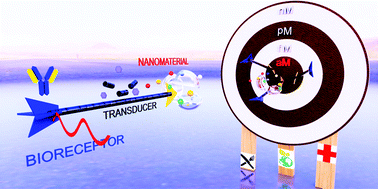Attomolar analyte sensing techniques (AttoSens): a review on a decade of progress on chemical and biosensing nanoplatforms
Abstract
Detecting the ultra-low abundance of analytes in real-life samples, such as biological fluids, water, soil, and food, requires the design and development of high-performance biosensing modalities. The breakthrough efforts from the scientific community have led to the realization of sensing technologies that measure the analyte's ultra-trace level, with relevant sensitivity, selectivity, response time, and sampling efficiency, referred to as Attomolar Analyte Sensing Techniques (AttoSens) in this review. In an AttoSens platform, 1 aM detection corresponds to the quantification of 60 target analyte molecules in 100 μL of sample volume. Herein, we review the approaches listed for various sensor probe design, and their sensing strategies that paved the way for the detection of attomolar (aM: 10−18 M) concentration of analytes. A summary of the technological advances made by the diverse AttoSens trends from the past decade is presented.



 Please wait while we load your content...
Please wait while we load your content...